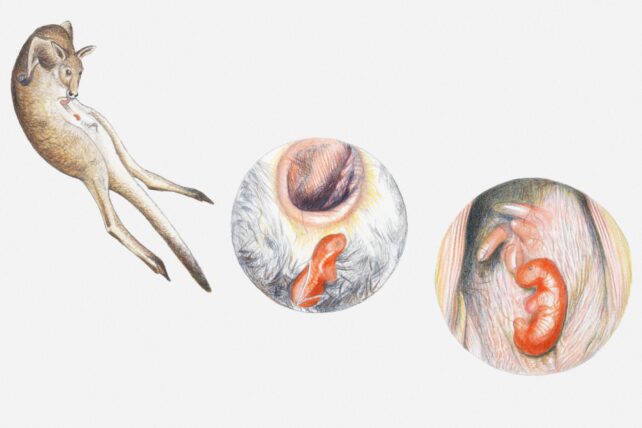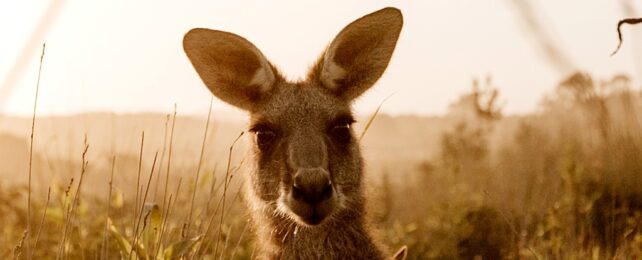A new study challenges the idea that marsupials are more 'primitive' than other mammals by showing their development has changed more since they last shared an ancestor.
"For a long time, people have treated marsupials as 'lesser mammals,' which represent the intermediate stage between placental mammals and egg-layers," explains evolutionary biologist Anjali Goswami from the Natural History Museum in the UK.
"It turns out that marsupials are the ones that are far more evolved from the ancestral form."
This now outdated idea arose from the fact that marsupials, such as kangaroos, give birth to young still in the early stages of development. This leaves their babies to do most of their development within pouches, seemingly a step more complicated than what egg-laying monotremes like platypus do, yet still simpler than placental mammal development.

Placental mammals – like us, whales, and hedgehogs – are born more developed after much more extended gestation periods.
"As a member of the placental mammals, we often have this bias that ours is the group that evolution is directed towards, but that's not how evolution works," explains Goswami.
Evolution is often misrepresented as a straightforward road to greater complexity, where species with more ancient traits are thought to be simpler or 'primitive'.
But genetics and a greater awareness of unusual traits demonstrate that complexity can be repeatedly gained and lost during a species's evolutionary journey. Nor does more significant evolutionary change always lead to more diversity, as there is far more variation in placental mammals than marsupials, the researchers point out.
Using specimens from the different developmental stages of 22 currently living species, Natural History Museum developmental biologist Heather White and colleagues constructed a timeline of changes that best explained what now exists.
The highly detailed set of 3D micro-CT scans revealed many more changes in how marsupial skulls develop. Specifically, skull development is slowed and shifted in marsupials, in comparison to both placental mammals and our shared therian ancestor from 160 million years ago.
The findings suggest that the extremely young age of marsupial births represents the more specialized type of development that required greater changes in traits compared to our shared ancestor than our strategy of allowing young to develop within us for longer.
Other studies hinted that this might be the case, with signs indicating both placentals and marsupials have substantially changed placentas from the yolk placenta of our common ancestor.
Moreover, a group of extinct mammals that split off from the rest of the mammalian branch of life before placentals and marsupials existed reproduce more like we do too.
"What we could clearly show is the marsupial way of developing is the one that's changed the most from the ancestor of marsupials and placentals," says Goswami.
"How marsupials reproduce isn't an intermediate form between egg-laying and placental mammals. It's just a completely different way of developing that marsupials have evolved."
You wouldn't know it, but this endangered northern quoll is packing eight babies- hairless and pink "jellybeans". She'll carry them for a couple more months before they head out into the big wild world. #wildoz #quollpatrol pic.twitter.com/W3umKj0m1k
— Judy Dunlop (@Judy_Dunlop) October 9, 2018
However, as White and colleagues were only able to include 22 species, more research is required to support their findings. There were some limitations in estimating the ancestral state due to the lack of early developmental examples from the platypus the team qualifies.
Either way, while comparing current traits to ancestral species allows us to establish relatedness and evolutionary timelines, it does not indicate how much more or less 'advanced' a species is in complexity. Instead, the changes most likely reflect environmental demands or lack thereof, as is likely the case here.
"It's been suggested that the marsupial strategy is better if you're living with a lot of environmental instability," says Goswami. "Placental mammals have long gestation times, so if an animal goes through a period where resources dry up, both mother and offspring would likely die because it's all internal."
"With a marsupial, it's a much lower risk strategy because the mother can easily abandon them at a very early developmental stage, so at least the mother can survive and try again later."
This may explain how marsupials made it all the way to Australia from their origins in North America when their placental neighbors did not, back when these continents were connected landmasses.
"One idea is that marsupials were better equipped to make this journey because of their more flexible reproductive system," speculates Goswami.
"So by stretching out development and making it more external to the mother, marsupials may be able to cope better with less stable environmental situations. But this is very much a guess and a hypothesis that needs to be tested."
This research was published in Current Biology.
